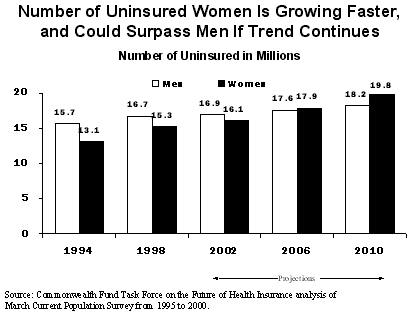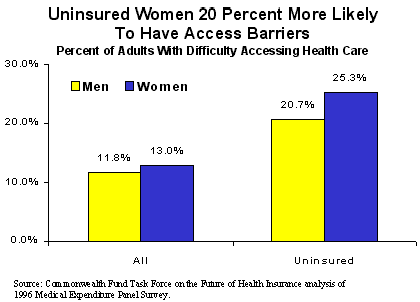Today, a report issued by The Commonwealth Fund and written by Jeanne Lambrew of the George Washington University documents disparities that women face in accessing both health care and health insurance. It projects that the number of uninsured women will increase and the unique challenges they face will only grow worse if current trends continue. Following a review of selected insurance coverage expansion approaches, the report concludes that building on insurance options that currently exist-employer-sponsored insurance and programs like the Children's Health Insurance Program (CHIP) and Medicaid-offer the most targeted and potentially effective approaches to increase access to affordable coverage for the nation's 15 million uninsured women. Commenting on the new report, Karen Davis, president of The Commonwealth Fund said: "In the aftermath of recent reports about insurance premium increases and a sagging economy, concern is rising about the difficulty of obtaining and maintaining affordable health insurance. The study being released today clearly illustrates how women, who are more likely to be caring for children or aging parents, are less likely than men to have good access to health care themselves." While women's higher rate of poverty and greater eligibility for Medicaid have translated into slightly fewer women than men being uninsured, this longstanding insurance coverage pattern is changing. In fact, should coverage trends continue, the number of uninsured women may actually surpass the number of uninsured men in less than five years.

Key findings of the report, "Diagnosing Disparities in Health Insurance for Women: A Prescription for Change" include:
- Overall, women need and use more health care services than men. More women than men have chronic illnesses and report fair or poor health. They are more likely to use services like mental health care and, as they age, prescription drugs. Over 80 percent of women ages 50 to 70 rely regularly on prescription drugs, compared with 71 percent of men in that age group.
- Uninsured women are nearly 20 percent more likely to have difficulty obtaining health care services than uninsured men. Moreover, among Americans ages 50 to 64, women are nearly twice as likely as men to have trouble accessing care.

- The number of uninsured women has grown three times faster than the number of uninsured men over the past five years. If this pace continues, the number of uninsured women will exceed the number of uninsured men for the first time in 2005.
- Uninsured women are more likely than uninsured men to be married, and the disparity is even greater for older women. Among the uninsured, about 49 percent of women are married, compared with 40 percent of men. Lower-income married women are often ineligible for Medicaid even though their children may be enrolled in (or eligible for) Medicaid or CHIP. Older married women (ages 55 to 65) are nearly 40 percent more likely to be uninsured than older married men, in part because their husbands meet Medicare's age 65 and over coverage requirement and they do not.
- Low-income mothers represent three of five low-income uninsured parents. In addition, they account for one-quarter of all uninsured women.
- Women ages 55 to 65 are over 20 percent more likely to be uninsured than men. As the baby boom generation turns 55 beginning this year, the number of uninsured women in this age group will likely increase by at least 50 percent. Over one-fifth of women over age 50 with a retired, older husband are uninsured.
- Women are a third more likely to turn down employer-based insurance and become uninsured, often because of cost. About 20 percent of uninsured women have the option of employer-based insurance but do not participate, compared with 15 percent of men. Not surprisingly, three of five of these women are low-income and probably cannot afford the premium, notwithstanding the fact that women tend to need health care and health insurance more than men.
- Women who work in small firms are somewhat less likely than men to be offered health insurance. Fewer women than men work in small businesses, but fewer women who work in small business are given the option of job-based health insurance (44 versus 47 percent).
- About 80 percent of uninsured women live in states that allow insurers of individual (versus group) insurance policies to deny coverage to applicants. In addition, about 75 percent of uninsured women live in states without constraints on the premiums that can be charged. Moreover, women may not get the benefits that they need, since individual insurance policies typically exclude or increase premiums for services like maternity care, prescription drugs, and mental health coverage.
The study also examines the impact of different approaches to expanding coverage to women. Findings include:
- Building on Medicaid and CHIP could rapidly and efficiently cover one-fourth of uninsured women. Providing additional federal financing to states to cover low-income parents would disproportionately benefit women and their children. It also would be relatively easy to accomplish since these parents' children are already eligible for or enrolled in these programs.
- Providing direct premium assistance to women workers through Medicaid and CHIP or other public programs to help purchase employer-sponsored insurance is likely to be more effective than subsidies administered through the tax code. Since Medicaid and CHIP provide greater and more targeted subsidies, innovative state partnerships with private employers and insurers are more likely to most effectively and efficiently target and enroll low-income women in employer-provided plans. Such approaches, however, need to ensure continuing employer financial participation and meaningful benefits to truly benefit women.
- Encouraging more employers to offer more employees health insurance through tax incentives could help the majority of uninsured women who lack access to job-based health coverage today. Tax incentives for employer-based coverage (e.g., tax credits for individuals purchasing coverage through small business purchasing coalitions; tax incentives for employers to encourage coverage of part-time workers) have potential to help uninsured working women-particularly those employed part-time or by small firms.
- Expanding the individual insurance market through tax credits is likely to be less effective in reaching uninsured women, especially low-income or older women. Since individual health insurance can be expensive for women in their childbearing years, or for women with a history of health problems, or for older women, it may not be an affordable option, even with a tax credit. In addition, lack of insurance protections, such as guaranteed issue and premium rating reforms, may make such an approach viable for only the healthiest uninsured women.
- Creating new insurance options for the near elderly, such as a Medicare buy-in, would help the growing number of uninsured women ages 55 to 65. Women in this age group are less likely to have access to employer-based insurance and are more likely to have trouble accessing or affording individual health insurance. Many of these women are married to retired men, some of whom are covered by Medicare. Extending the eligibility of public programs like Medicare or the Federal Employees Health Benefits Program to people ages 55 to 65 or at least to spouses of Medicare beneficiaries could provide an affordable alternative that disproportionately benefits women, who are more likely than men to be uninsured at this age.


